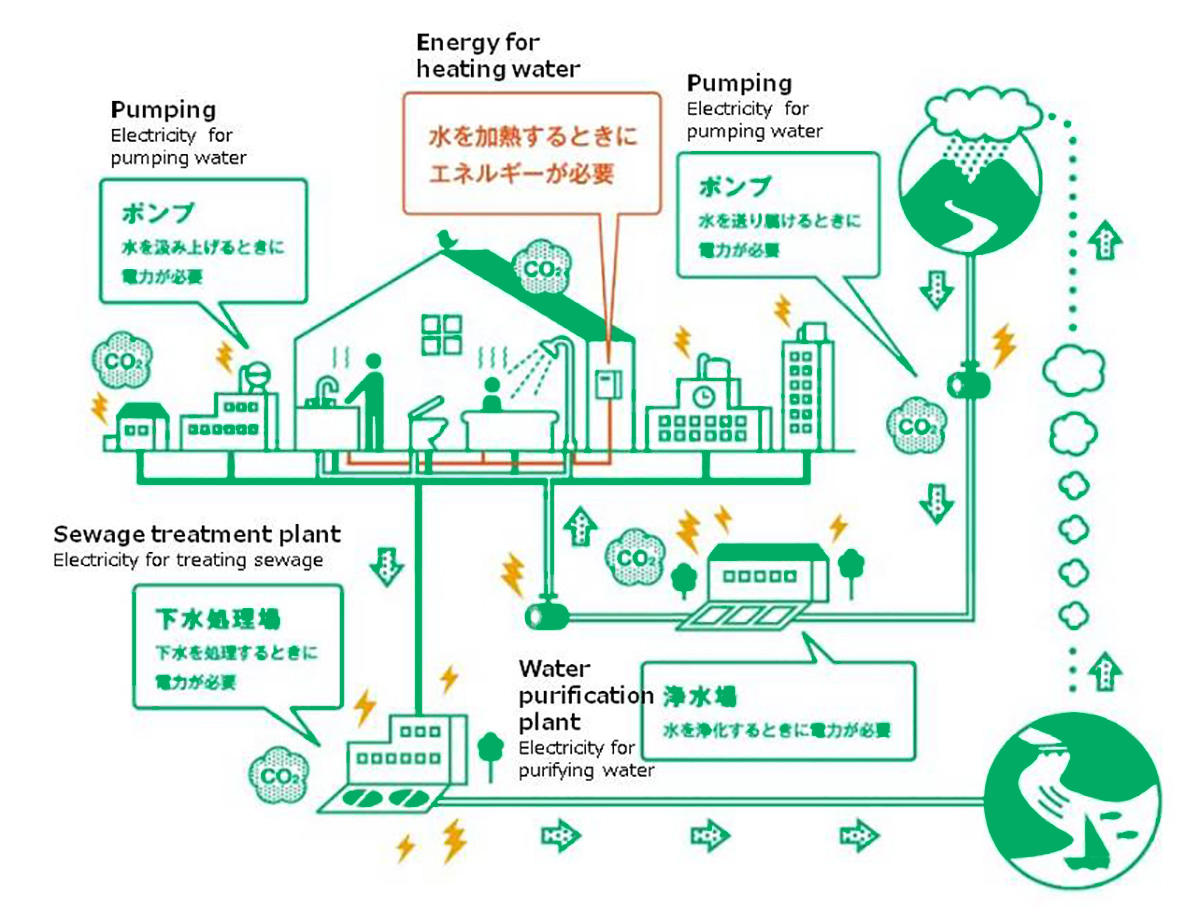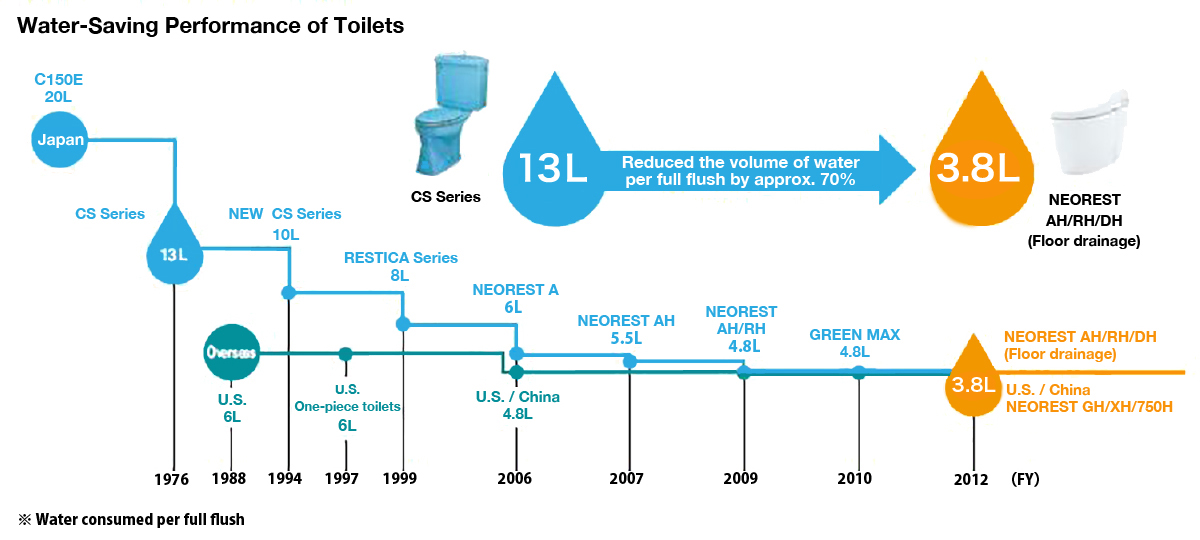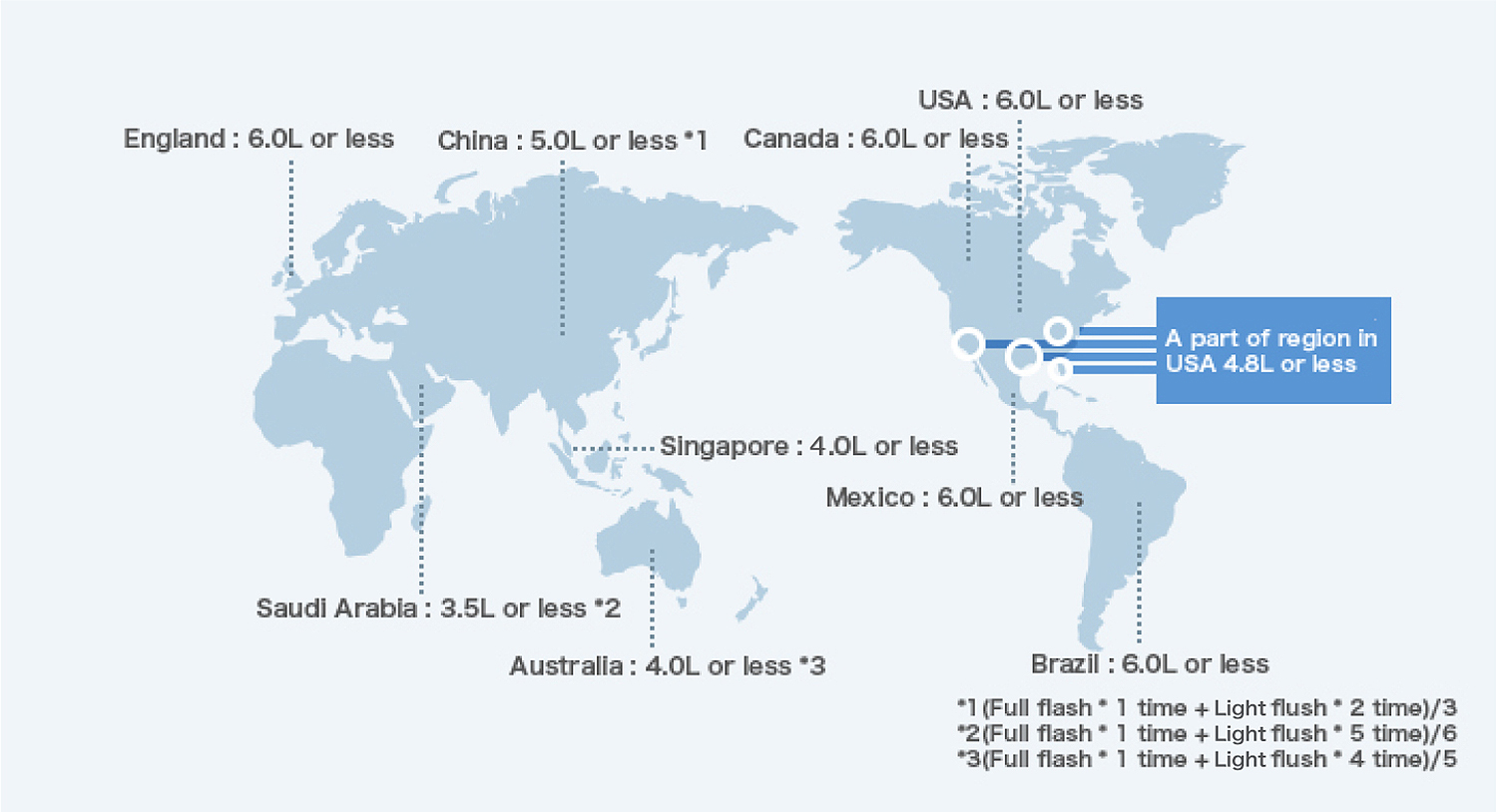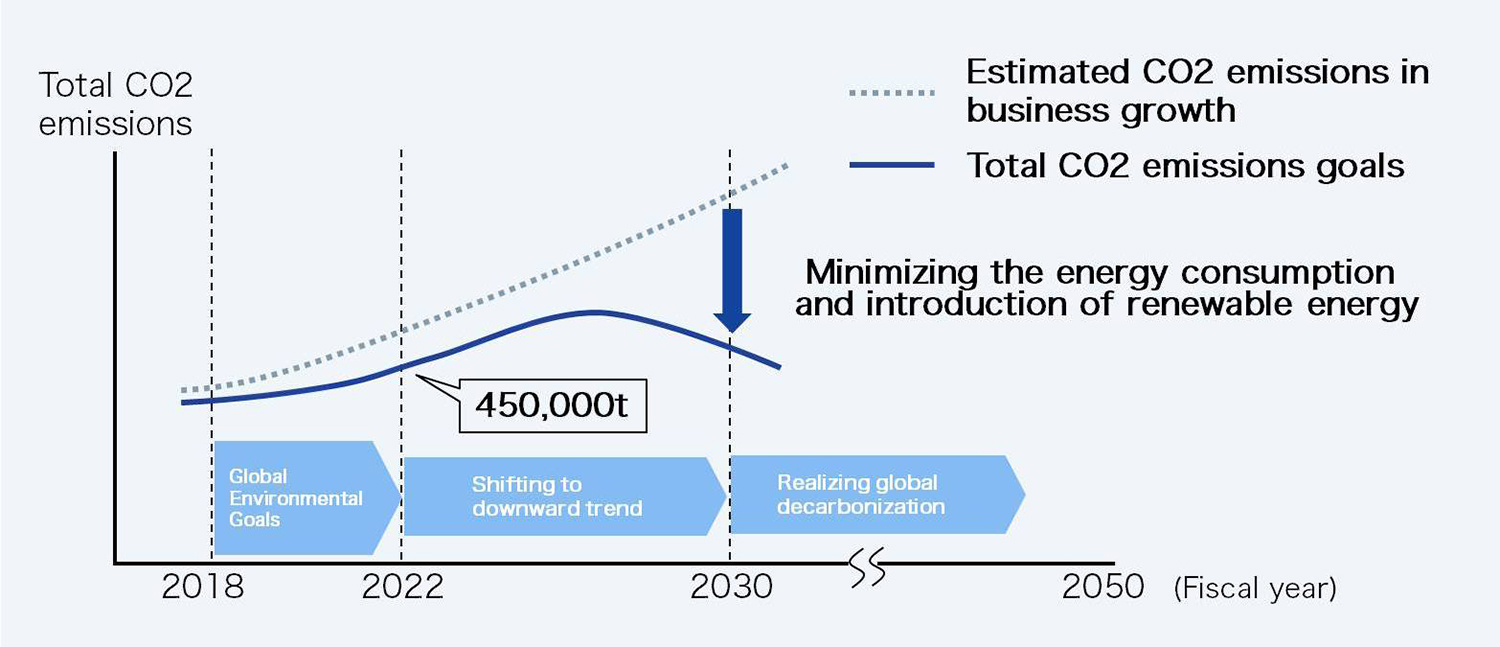Reduction of CO2 emissions during the use of TOTO products through water-saving and energy-saving products
TOTO LTD.
Outline
Coinciding with the implementation of our mid-term management plan, TOTO WILL2022, the TOTO Global Environmental Vision was revised and put into effect in April 2018. This vision acts as a driving force for TOTO WILL2022. By strengthening the promotion of this vision, we are aiming to further integrate our management and CSR activities and increase our corporate value.
The TOTO Group views climate change as a material issue facing society. Accordingly, guided by the TOTO Global Environmental Vision, we will undertake initiatives from a long-term perspective toward the year 2050 for the realization of a decarbonized society on a global scale.
TOTO products have a long life cycle, and the use phase accounts for 93% of the CO2 emissions during the product life cycle. In this context, we see as our mission to reduce CO2 emissions in a variety of ways available to us, such as reducing the emissions at the use stage (including contribution to net zero, adaptation, resilience, etc.) and increasing the sales ratio of water-saving and energy-saving products. As for toilet bowls, our main products, we will work on to implement technologies that clean the bowl stably with less water and to spread use and expand the sales globally. “In the manufacturing stage” on the other hand, there is a challenge that CO2 emissions tend to increase year by year as business grows. We meet this challenge by minimizing energy consumption in our business activities while actively promoting renewable energy throughout the TOTO Group in order to secure long-term business growth. In this way, TOTO is working on the reduction of CO2 emissions in order to realize Net Zero Emissions. Furthermore, with the long-term aim is to realize a global carbon-free society, TOTO will commercialize and utilize Solid Oxide Fuel Cells (SOFC) and develop particulate photocatalyst sheets by cooperating with other companies and by participating in the industry-academia-government collaborative framework.
Description
1. Reduction of water consumption and CO2 emissions during the use of TOTO products
As a result of such factors as the global population increase in recent years, economic development, and climate change, by 2050 the amount of water that can be consumed annually by each individual is estimated to be reduced to three-quarters of the amount in 2010.
Saving water and hot water used around toilets, bathrooms, kitchens, washrooms, etc. can contribute to a reduction in CO2 emissions.
Because, in using water, we must consume energy, mostly in the form of electricity, as many pumps are used to deliver water to water purification plants, sewage treatment plants, and each household. Furthermore, energy for heating is needed to use hot water, which generates more CO2.
TOTO products have a long life cycle, and the use phase accounts for 93% of the CO2 emissions during the product life cycle. To improve the situation, the TOTO Group is developing and globally spreading water-saving and energy-efficient products. With those products, TOTO is working on the reduction of CO2 emissions in the product life cycle (including contribution to net zero, adaptation, resilience, etc.), while contributing to the alleviation of the world’s water problem.
As an indicator, we have set targets for reducing water consumption by 1.1 billion m3 and reducing CO2 emissions by 3.7 million tons in 2022 compared to the hypothetical case where we would continue promoting products with the performance level of FY 2005. In FY 2018, we reduced water use by 860 million m3 and CO2 emissions by 3.23 million tons.
In developing products with high water-saving and energy-saving effects and marketing them globally, we examine and tackle the challenges by focusing on the features below:
a) Product performance improvement: CO2 reduction by the improvement water-saving and energy-saving performance of each product
・【Development】 Water saving toilets
The function of the toilet flush is not only to remove the waste from the toilet bowl but also to carry it through the pipe. Tornado Flush does these two tasks stably and reliably with a small amount of water by creating a circulating whirlpool. On the other hand, as cleanability and cleanliness are also essential for maintenance of the toilet bowl, we introduced the easy-to-clean rimless shape of the bowl and developed CeFiONtect, a super-smooth surface technology that creates a high-purity glass coating with nano-level smoothness in the firing process. In this way, TOTO has developed toilet bowls that have both reliable flushing efficiency and cleanability with an amount of water as little as 4.8 L. In addition to the above technologies, TOTO has also developed a cleaning method called the Hybrid Ecology System that optimally combines the water flow pressurized from the built-in tank and tap water flow. With this system, we have realized efficient water flushing with an even smaller amount, 3.8 L, of water without an influence from the water pressure of the water supply. Thanks to such improvements, TOTO is developing water-saving, high-design toilet bowls with a low silhouette and a smaller tank and marketing them globally
・【Development】 Water saving showers
As mentioned above, reducing the use of hot water is more effective for CO2 reduction than reducing that of cold water. However, simply reducing the flow rate of the shower may reduce the comfort of showering. Furthermore, the flow rate is greatly affected by the water pressure of the area. As a solution to that, TOTO has developed a unique shower nozzle that blasts out large vibrating drops of water by generating multiple vortices along the water path. This technology enabled the nozzle to save water by 35% compared to the previous models, while offering an excellent shower experience with moderate stimulation at low water pressure. We will commercialize and market globally this technology with our Comfort Wave shower products.
b) Strengthening the sales of water-saving and energy-saving products: CO2 reduction by increasing the sales ratio of water-saving and energy-saving products
The TOTO Group is focusing on not only (a) improving product performance, but also spreading water-saving and energy-saving products.
・【Dissemination】 Water saving toilets
As sanitary ware is a kind of earthenware that needs to be fired, its dimensions shrink significantly by firing. The ratio of shrinking differs at different parts of product. Moreover, since the above-mentioned Tornado Flush and Rimless bowls have more complex shapes than ordinary toilet bowls, higher-level technology is required in the production process, such as mixing of raw materials, molding, drying, and firing. Similarly, super-smooth surface technologies, such as CeFiONtect, requires a high-level technique called seyū, viz, the spraying of the glaze before firing. In order to promote water-saving toilet bowls globally, TOTO establishes its own factories not only in Japan but also overseas to produce them. Furthermore, every year we hold the sanitary-ware making competition where the selected staff of TOTO factories in different countries gather and compete in molding and glazing techniques. By competing, our staff worldwide improve and develop their techniques. Regarding the product lineup, we limit the amount of flush water for all our main products to 4.8 L or less, again aiming to spread the use of water-saving toilets. As a result of these efforts, the percentage of water-saving toilets with a flush water volume of 4.8 L or less in the total shipments of TOTO toilet bowls has been increasing year by year, having reached 79% in FY 2018. We will continue to make efforts to increase the ratio of water-saving toilet bowls by promoting them further.
・【Dissemination】Instantaneous Type Washlet
In addition to water-saving toilets and showers, we are also switching the Washlet, cleansing toilet seats using warm water, to the energy-saving type. There are two types of Washlets: the "hot water storage type" that keeps the water in the tank warm with a heater, and the "instantaneous type" that heats up instantly only the amount of water used each time. The instantaneous type consumes less energy than the conventional hot water storage type, but requires a high-level technology in controlling the heater and water flow. TOTO will actively disseminate the value of the instantaneous type, and enhance the switch to it. In our future global sales strategy, we will promote the instantaneous type Washlets in the overseas markets, too.
c) Lowering of various factors: CO2 reduction by improving emission factors of electricity, water and hot water
As one of the changes in social infrastructure, the electricity emission factors are expected to get smaller thanks to the spread of renewable energy use. Along with that, the CO2 conversion factor of water will decrease because of the reduction in carbon in the electricity used for water supply and sewerage. TOTO will contribute to the realization of a carbon-free society through synergistic effects of TOTO products and the broader change of the energy landscape, including electrification with EcoCute and the transformation of city gas to renewable energy, shifting from city gas, LPG gas, and oil, which have been the main sources of hot water supply energy for households
2. Curbing Total CO2 Emissions from Business Sites
In 2019, the TOTO Group endorsed the recommendations of the Task Force on Climate-related Financial Disclosures (TCFD). The group has been and will keep working on CO2 reduction, after and before reaching the peak of total CO2 emissions at its offices by 2030. The plants for manufacturing sanitaryware, TOTO's main products, have facilities that consume a large amount of energy, for example, firing furnaces. As such, the total CO2 emissions had been increasing year by year as the business grew. The above being the case, TOTO will work on the minimization of energy consumption in our business activities by creating environmentally friendly green factories, while actively introducing renewable energy throughout the TOTO group. By doing those, the group will reach the peak of CO2 emissions by 2030.
・【Dissemination】 Introduction of the latest energy-saving technology
The TOTO Group recognizes the issue is that the kiln consumes the most energy during the manufacturing process of sanitary ware such as toilet bowls and urinals. Therefore, The TOTO Group introduced the high efficiency, self-regenerating fiber kiln which recovers waste heat. By recovering waste heat during product cooling, and then reusing the waste heat, about 71% energy savings is achieved compared to a conventional brick-type firing kiln.
Similarly, high energy consumption in the molding room is the issue. Therefore, introduction of a state-of-the-art, high energy-saving performance air conditioning equipment in the molding room where there is a need to keep the temperature and humidity constant throughout the year. There is increased energy and power savings compared to conventional methods by recovering waste heat from cooling and using it for heating, and by individually controlling the air conditioning to match the load conditions.
In addition, adoption of high thermal insulation materials on the roof and outer walls. The performance of the air conditioning equipment is also maximized by considering layouts, such as placing the area requiring heavy use of air conditioning in the center of the building where it is less susceptible to the influence of outside air.
・【Dissemination】 Promotion of fuel conversion
While introducing the latest energy-saving technology, we are accelerating a fuel conversion to fuel and electricity with low CO2 emissions used in our business activities. Specifically, the fuel for sanitary ware production facilities (firing furnaces, boilers, water heaters/coolers) has been converted from LP gas to city gas, and the energy source for melting equipment in the casting process of enamel products has been changed from coke to electricity.
3. Commercialization and utilization through cooperating with other companies as well as by participating in the industry-academia-government collaborative framework.
The TOTO Group actively cooperates with other companies and participates in the industry-academia-government collaborative framework in order to tackle the challenges for the realization of a decarbonized society. In those collaborative projects, we have been working on the commercialization and utilization of Solid Oxide Fuel Cells (SOFC), a compact yet highly efficient power generation system, and the development of particulate photocatalyst sheets, which can accelerate the commercialization process of hydrogen production by artificial photosynthesis that would lead to the mass supply of cheap hydrogen.
・【Technological development】 Artificial Photosynthetic Chemical Process (artificial photosynthesis project)
The New Energy and Industrial Technology Development Organization (NEDO), the Japan Technological Research Association of Artificial Photosynthetic Chemical Process (ARPChem), Tokyo University, and TOTO Ltd. are cooperating in NEDO’s artificial photosynthesis project and have developed particulate photocatalyst sheets that use two types of photocatalyst particulates for hydrogen production from water (a type of artificial photosynthesis) by photocatalyst using solar energy and achieved a solar energy conversion efficiency of 1.1%. Furthermore, extending the concept of that sheet, we have succeeded in creating printable coating with the size of 10 cm square by screen printing that would enable mass production. The printed sheets have a very simple structure, suitable for size increases and cost reductions, and have the potential to supply inexpensive hydrogen on a mass scale. As a member of this artificial photosynthesis project, TOTO will continue to work for the development of innovative technologies that can reduce carbon dioxide emissions, thereby contributing to the realization of a sustainable society.
・【Technological development】 Solid Oxide Fuel Cell (SOFC)
SOFC, a compact yet highly efficient power generation system, is expected to be one of the solutions for energy and environmental problems in various fields, such as household, commercial, and industrial ones. However, the level of technology required for its development is very high, for example, the technology of the functioning of materials, mainly ceramics, in a high temperature reactive atmosphere. Currently, reducing cost and improving durability are the main challenges for commercialization and utilization of SOFC. As it takes a long time to evaluate the lifespan and to research and develop technologies accordingly, a considerable amount of labor and cost is needed for the commercialization of SOFC. For this reason, four Morimura Group companies (Noritake Co., Ltd.; TOTO Ltd.; NGK Insulators, Ltd.; and NGK Spark Plug Co., Ltd.) have established the joint venture Morimura SOFC Technology Co., Ltd. The joint venture aims for quicker commercialization by bringing together the technologies and know-how related to the SOFC that the four companies have accumulated so far, while integrating the managerial resources of each company.
Partner(s)
【Technological development】
Artificial Photosynthetic Chemical Process (artificial photosynthesis project)
Participating Organizations (Japanese alphabetical order): INPEX Corporation, Japan Fine Ceramics Center, Sumitomo Chemical Company, Ltd., TOTO Ltd., FUJIFILM Corporation, Mitsui Chemicals, Inc., and Mitsubishi Chemical Corporation.
【Technological development】
Solid Oxide Fuel Cell (SOFC)
Four companies of the Morimura group (NORITAKE CO., LIMITED, TOTO Ltd., NGK Insulators, Ltd., NGK Spark Plug Co., Ltd.)
Supplementary information
[Outline]
Integrated Report
https://jp.toto.com/en/company/profile/library/pdf/2019_report_en.pdf
For the tomorrow of water and the earth
https://jp.toto.com/greenchallenge/value/q07.htm
[TOTO products]
Water saving toilets(toilet bowls / urinals )
https://jp.toto.com/en/company/csr/environment/water/products.htm
Baths
https://jp.toto.com/en/company/csr/environment/warming/products.htm
[Others]
・Artificial Photosynthetic Chemical Process (artificial photosynthesis project)
https://jp.toto.com/company/press/2016/03/10_002092.htm
・Solid Oxide Fuel Cell (SOFC)
https://jp.toto.com/company/press/2019/03/04_005705.htm
https://jp.toto.com/company/press/2019/12/03_009224.htm
Similar Innovation Challenges
Accelarating the penetration of renewable energy resources with “Open Energy System”
Sony Group Corporation
Achieving net-zero carbon emissions from plant factories using full artificial lighting
Taikisha Ltd.
Advanced technology for buildings providing energy-saving and comfortable indoor environment (under Net Zero Energy condition)
Mitsubishi Electric Corporation
AI control reduces base station power consumption by up to 50%
KDDI CORPORATION










